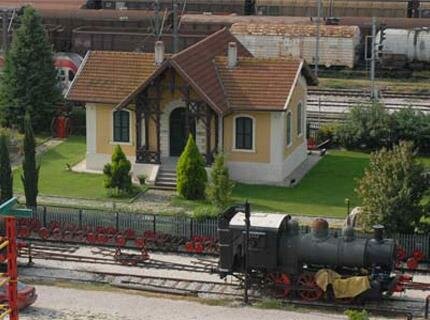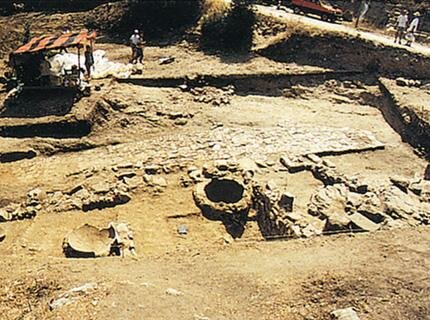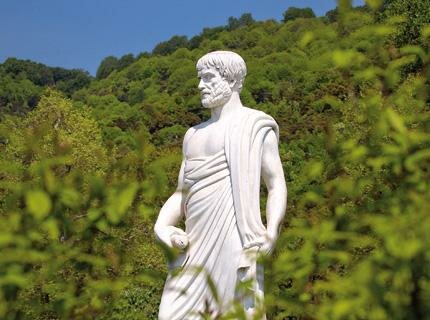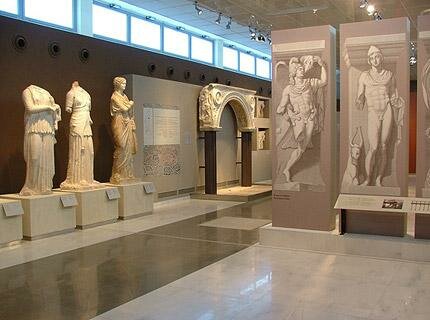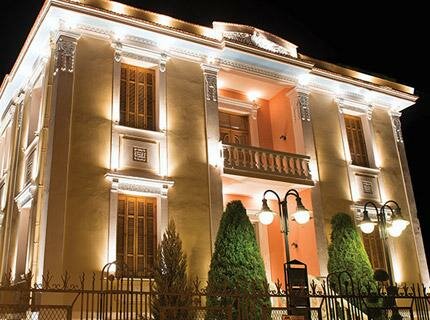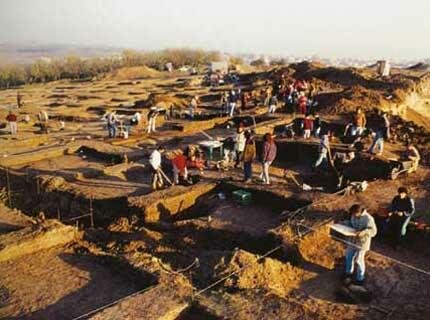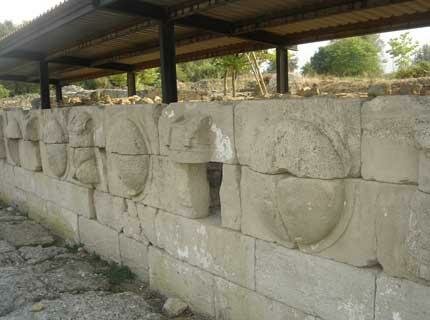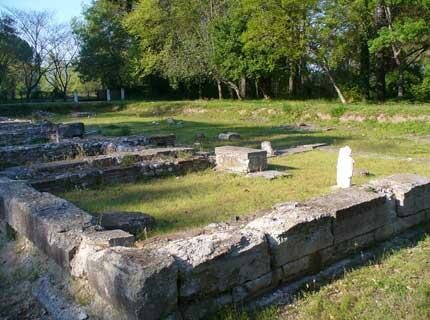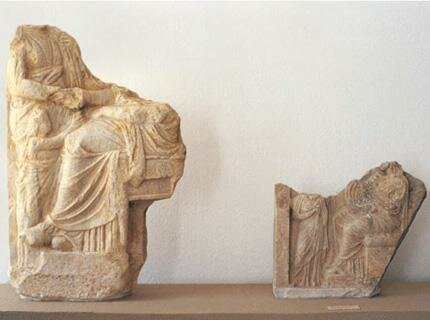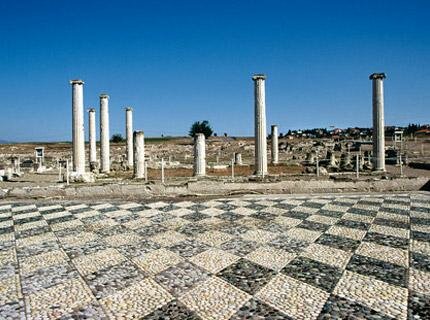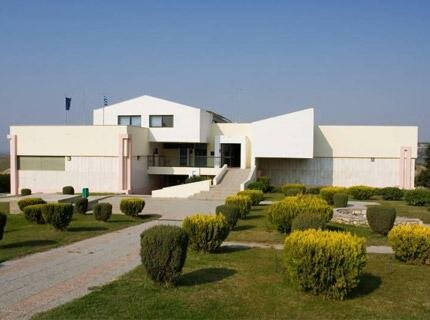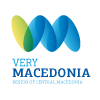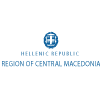Culture
The building of the Military Station (Station Militaire) of the Railroad company «Jonction - Salonique - Constantinople» at Thessaloniki.
Is located at the west side of Thessaloniki approxamately 500 meters after the overpass bridge of Monastiriou road to the exit of the city, between main rail lines emanating from the New Railroad Station and convent within the administrative boundaries of the Municipality of Kordelio - Evosmos.
The building had been constructed at the end of the 19th century (in particular from 1891 until 1894) when the city was part of the Ottoman Empire. It had been designed by the Italian architect Pierro Arigoni who had also designed the Casa Bianca building during 1911.
http://www.sfsth.gr/
The theatre was accidentally discovered in 1992, on a natural slope and it probably belonged to the ancient Macedonian city of Mieza. The cavea has fifteen rows of seats carved in the rock. The scene complex comprises the built proskenion which has a facade with doric semi-columns and the skene which is unfortunately preserved in a poor conndition. Its capacity is estimated at 1,500 people. The theatre was constructed in the late Hellenistic period.
After its accidental discovery, in 1992, the excavation of the monument began and is still conducted by the archaeologists V. Michailidou and V. Allamani.
http://kopanos-imathias.blogspot.com/
E. Heuzen and N.Hammond posit that this was the site of the Battle of Pydna (168 B.C.), the outcome of which being the subjugation of the Macedonians to the Roman Empire.
The ruins of a Bishop's Palace from the 5th-6th C. was found to the east of the railway line from Thessaloniki to Athens.
A square tower, 80x90 m. was found situated on the Ancient Road from Pydna to Dion. The area was built on a plan which included four fortified towers, within the confines of which a 3 chambered Basilica and a Bishop's Palace, bounded by a covered aisle have been found.
The foundations of the buildings from 479 AD are probably those of the seat of the Bishop of Pydna.
The Bishop's Palace was built on the ruins of the 2nd century baths, a mosaic floor having been found beneath its floor, and to the East of the Palace is a villa with mosaic floors dating from the time of Konstantinou and the foundations of a building which were probably those of the local tax collector's offices.
The plan with four towers remained until the time of Justinian, when its fortified character changed due to the enlargement of the warehouses and workshops for the production of wine and olive oil. It was destroyed by an earthquake in the middle of the 6th Century, after which the church was rebuilt on the central slope, the previous building area being converted into a cemetery.
The town must have been abandoned during the Bulgarian invasion at the end of the 9th Century. Today's visitor can see three of the towers, the Bishops Palace, the mosaic floors of the 4th C villa, the tombs, the springs, the ovens for baking the tiles and those in which glass was fired.
An ancient city with an Acropolis, homeland of the mythical Orpheus, it was situated between Ancient Leptokarya and Skotina, at the entrance to the great chasm which divides Lower from Upper Olympus
Excavations of the site were begun by the Byzantine Society of Thessaloniki in 1954. The repeated flooding of the area created the beds of the streams of Zilianas.
The Archaeological site extends for over 1,500 sq, kilometers (the city, Acropolis, Cemetery, etc.) surrounded by the beds of the streams, which were covered by age old plane forests.
This extends over the vast bulk of Mount Olympus being a continuation of this historical and archaeological area, and includes:
a) An enclosed Acropolis (about 15 stremmata in extent) which appears to date from the Hellenistic age. This place shows traces of the bed of the Grivas torrent, the remains of whose banks protected the ancient surrounding walls, built of squared stone.
b) The ancient settlement which was built to the North West and above The Acropolis. This date from prehistoric times to the Byzantine era.
c) An ancient cemetery possibly dating from the prehistoric period and the early Greek age (Mykenes, the Iron Age and early historical times.)
Stone walls, internal floor spaces, cobbled roads outside, coins and objects of worship are those things which have been excavated in the early stages of the project.
It is one of the biggest museums in the world for Byzantine heritage, housing an impressive 2900 artifacts of the early Christian period and the middle and late Byzantine period –its permanent exhibition. The museum accommodates temporary exhibitions from all over the world, while continuing to organize a variety of special educational activities.
http://www.mbp.gr
⇠ Thessaloniki 108km ⇠ Polygyros 52km
Stagira is a Greek village situated at the foot of the Argirolofos hill. The village stands approximately 8km southwest of the ancient Stagira, the birthplace of Aristotle. The village’s former name was Sidirokafsia and dates back from the Byzantine Era. The area is mentioned already in the beginning of the 10th century AC, when the mines were in full operation. Later on, monasteries from Mount Athos took over their management. From the 15th century and through all the years of the Ottoman Occupation, the mining and elaboration of the minerals became more intense, mainly when the village was under the control of Madem Agas. In the 16th century a castle was built, of which there are still remainders to be seen. During mint century the village also had its own mint.
Sightseeing
• Aristotle’s park. The Theme park is located in a most beautiful area with a marvellous view towards the gulf of Ierissos and the whole peninsula of Athos. When the weather is good you can see some of the monasteries on Mount Athos using a telescope. It also includes a series of other instruments which when used properly will show the phenomena of nature. All of this is dedicated to the famous philosopher and his work called “the Natural”. The instruments include a prism, optical discs, sounding bars, a compass, sundial and pendulum – all illustrating important phenomena studied by the great philosopher.
• The fortress complex, of which only three partly ruined towers exist today as well as the ruins of the public bath that Ishak Pasha constructed in the 15th century.
• The central temple dedicated to the “Birthday of the Virgin Mary”, built in 1814. Also interesting is the small chapel dedicated to the “Virgin Mary the Spilotissa” built in rock.
• The ruins of Sidirocaussia. Many ruins exist around the hill of St. Demetrios (the site of the bath).
✓ can’t miss this!
Walk in the evergreen paths and admire a panoramic view.
More about Ancient town Stagira
The birthplace of the philosopher Aristotle was a colony of Andros, founded in 655 B.C. The first name of the city was Orthagoria. Ally, initially of the Athenians and later of the Spartans, the city was occupied by Philippos in 349 B.C., after the destruction of Olynthos. Philippos, however, rebuilt the city in order to honour the great philosopher, tutor of Alexander the Great. When Aristotle died, his fellow-citizens transported his bones to Stagira and set up a monument. The excavations in the region began in 1990. The most impressive piece that was brought to light is the wall, at the top of the hill that was built in the classic years. The different ways of construction can be distinguished. The wall determines the western limits of the ancient city, surrounded by the sea. The powerful fortification supplemented round and square towers and ramparts that connected with heavy scales. At the top of the hill also appears the relic of the citadel. At the part behind, between the hills, is the well-maintained remainder from some beautiful, spacious public building, with a gallery and a monumental facade with pillars.
Aristotle (384 BC – 322 BC) was born in Stagira. He was a Greek philosopher and polymath, a student of Platon and teacher of Alexander the Great. He is one of the most important founding figures in Western philosophy. Aristotle’s writings were the first to create a comprehensive system of Western philosophy, encompassing morality and aesthetics, logic and science, politics and metaphysics. Aristotle was appointed as the head of the royal academy of Macedon. During that time he gave lessons not only to Alexander, but also to two other future kings: Ptolemy and Kassander.
More about Aristotle’s park
Aristotle’s park is located in Stagira. The Theme park includes a series of other instruments which when used properly will show the phenomena of nature such as: Solar, Lens, Pentaphone, Optical Discs, Pendulum, Water turbine, Inertia spheres, Parabolic reflectors and Telescopes. Aristotle’s Park is an excellent place to learn about activities and interactive games. When the weather is good, you are able to see some of the monasteries on Mouth Athos, using the telescopes.
We welcome you to visit the Museum. Immense yourself in the stories that it has to tell you, see and listen to how an object can “make” history. In addition, come to experience and enjoy all that a modern museum can offer: educational programs, exhibitions of ancient and modern culture, workshops, academic talks, seminars and recreational activities.
The Archaeological Museum of Thessaloniki is a space of culture and learning, open for everyone.
6 Manoli Andronikou Street,
PO Box 506 19
Postal Code 540 13, Thessaloniki, Greece
tel. +30 2310 830538
fax. +30 2310 861306
www.amth.gr
The Museum of the Macedonian Struggle has perhaps the richest of all collections of relics and documents from the period of the Macedonian Struggle. Some of these items form part of the Museum's permanent collection, while others remain in the Research Centre for Macedonian History and Documentation (KEMIT) or in store for use after the reconfiguration of the Museum's exhibition space.
Museum for the Macedonian Struggle 23 Proxenou Koromila, GR 54622, Thessaloniki, Greece
Τ. 2310229778
Fax. 2310233108
E:
http://www.imma.edu.gr/
To the west of Ancient Pydna and the South west of present day Makrigialos lies one of the largest pre-historic settlements in Greece.
It came to light as the result of excavations carried out by the 16th Society for Prehistoric and Classical Studies, which began in1992.
The site was excavated over an area of 60 sq km, though it is estimated that the area of the settlement covered something like 500 sq. km.
It included dwellings and land under cultivation, and artifacts such as clay pots, stone tools from a wide range of materials and small utensils were found. Idols made of clay and marble also came to light, as did the charred remains of seeds and a plethora of animal bones.
On the slopes of Olympus, a mere 5 km from the beaches of Pieria, Ancient Dion, the Holy City of Macedonia was found under a covering of undergrowth and water. This city had been a thriving centre of civilization from the time of its foundation for a period of 1,000 years from the 5th c, BC to the 5th c, AD.
We learn from Ancient Greek writers that the Macedonians regularly gathered in Dion to worship the Gods of Olympus, and to make sacrificial offerings, as can be seen from the objects found on the site. It was here that King Archelaos organized athletic competitions and theatrical events, and Philip the Second celebrated his victories at Dion, as did Alexander.
It was here that Alexander gathered together his troops to prepare for his journeys of conquest, worshipping Zeus, King of the Gods of Olympus. In the temple of the Gods of Olympus was a magnificent bronze statue created by Lissippos, which depicted the 25 horsemen who died at the Battle of Granikos.
During the reign of Philip the 5th after a disastrous invasion, the Aetolians ransacked the city. At the Battle of Pydna, 168 BC, the death of Perseas, last King of Macedonia, brought an end to the Macedonian Dynasty. Dion became integrated into the Roman colony during the reign of Augustus.
The second peak of the city came during the Roman occupation in the 2nd and 3rd centuries AD, when it became "reborn" as a Greek city. The final days of Dion were written when it was destroyed by an earthquake and floods in the 5th c AD. The terrified citizens of the city took flight and sought refuge on the higher slopes of Olympus.
The Holy City of the Macedonians collapsed and its ruins lay beneath the soil of the Macedonian earth.
⇠ Thessaloniki 61km
The capital city of Halkidiki is located in the center of the region. Polygyros was built on the southern slopes of Mt. Holomontas at an altitude of 550 meters. Its name is thought to have been inspired by the many twists and turns in the endless surrounding hills. Another explanation stems from “Poly-geros” or “very-strong”, a reference to the good climate but also possibly “Poly-ieros” or “very-holy”, because of a temple that used to exist in the area. There have been references to Polygyros since Byzantine times, and it is where the Halkidiki uprising started on May 17, 1821. Today, small hotels and guesthouses are available for an overnight stay while tavernas and quaint ouzo bars provide traditional local delicacies. Throughout the year Polygyros organizes various cultural events.
Sightseeing
• The traditional web of narrow streets with their old houses. The scenic location of Exi Vrises is well-known, named after its six water taps. A restaurant and a coffee shop located here, are the ideal places to relax and grab a bite.
• The Archaeological Museum with findings from the entire Halkidiki (Olynthos, Potidea e.t.c.).
• The Folk life Museum at Karaganis Mansion.
• The Church of Metamorfosi (Transfiguration): Byzantine church with murals, built in an old prison property.
• Country church of Prophitis Elias (Prophet Elijah).
• The Church of St. Demetrios, built in 1871 at the site Bares.
• Church of Saint (Agios) Modestos with the icon of the saint that was painted in the 15th to 16th century by Monks from Mount Athos.
• Just 6km down the road that leads to Taxiarchis -situated above the general hospital- is the location known as Tsoukalas, which offers a panoramic view of the township.
• A short distance from Polygyros, in the area called Paleporta, was the ancient town Apollonia, southwest from where the city lies today. Here, the visitor can still see part of the castle walls foundations.
✓ can’t miss this!
The Carnival feast: 10 days of events that culminate with the parade of carvival floats on the last Sunday of the carnival period.
Taxiarchis is home to a branch of the Forestry Department of the University of Thessaloniki, due to its forest of Christmas trees.
More about Archaeological Museum (Polygyros)
The Museum has a fascinating collection of archaeological finds from all over Halkidiki. Exhibits include clay figurines and coins from Olynthos, vases from Toroni, parts of the roof of the temple of Zeus Ammon from Kallithea, reliquary chests, fisherman’s equipment, lamps, jewels and amphorae from Akanthos, now the town of Ierissos, and funerary steles and the statue of a woman from the 1st century BC, from the sanctuary of a deified hero, from Stratoni.
(More Info: T +30 23710 22148).
In the land of Alexander the Great.
Set out on a magical journey through time to the glorious kingdom of ancient Macedonia, where Alexander the Great was born. Peer into the rich history of the Macedonian state capital, a bustling metropolis of the Classical period. A number of excavations of the site reveal the ancient city’s majestic grandeur.
Visit the monumental palatial complex that occupies the northernmost hill of the city, and covers an area of 60.000 m2. Wander around the city’s commercial and manufacturing centre, the so-called agora (ayorá), which was in fact the biggest agora of the ancient world. This huge building complex of 70.000m2 included shops, workshops, administration offices, and the repository of the city’s historical records. The main avenue of agora was actually connected with the city’s port, the ruins of which are still visible today.
The ancient agora is constructed according to the famous urban planning of Hippodamus (Hippodamian grid plan): well-defined city blocks, paved streets with sidewalks, and elaborate water supply and sewage systems. They all illustrate Pella’s modern infrastructure and sophisticated urban design. The two-storey private housesbuilt in Doric and Ionic style brings to mind images of a prosperous, ancient, city.
You will certainly be impressed by the outstanding mosaic floors that used to decorate the city's grand mansions – the most famous are the ones depicting the Abduction of Helen, Rapture, the Amazonomachy (the battle of Amazons), and the Deer Hunt. You can marvel at these decorated floors (considered the most important group of mosaics in Macedonia) at the New Archaeological Museum of Pella.
http://www.visitgreece.gr/en/culture/archaeological_sites/ancient_pella
Two kilometres from the Thessaloniki–Kavala national highway, just above the mouth of the River Strymon, is the archaeological site of ancient Amphipolis (a city founded in 437 bc) and the Archaeological Museum.
The museum is housed in a new building that was completed in 1995. The finds are displayed in chronological order and comprise the following groups: the prehistoric period (from Mount Pangaio and Ketil Tepes Hill); the Archaic period (from Kasta Hill and the Iron Age cemetery at Amphipolis); the Classical and Hellenistic periods (from the Archaic Gymnasium, the Hellenistic cemetery, the Hellenistic house, and from excavations on the archaeological site), the Roman period (mosaics from a Roman house and from excavations in the local cemetery); the Early Christian period (from five Early Christian basilicas at Amphipolis); and the modern era (from a chapel found at a low elevation near Nea Amphipoli).
Address: Amphipolis, GR 650 52 Serres, Macedonia, Greece
Opening Hours: Tuesday–Sunday: 8.00–14.30
Monday: closed
http://www.macedonian-heritage.gr/Museums...
http://odysseus.culture.gr/h/1/gh151.jsp?obj_id=3250
The archaeological site of Dion (meaning “the city of Zeus” in Greek) is located in the Pieria region, about 30 minutes from Thessaloniki. It boasts a large temple dedicated to Zeus, a series of other smaller temples and a 2,200 year-old exquisite statue of the Greek goddess Hera. It was in Dion that Alexander the Great assembled his army before he began his conquests to the west.
The exhibition is arranged in chronological order, in three rooms: Room A (vestibule) contains finds of the prehistoric period. Of the most important exhibits are the Neolithic figurines and tools from the settlement at Kolchis (case 1, upper and lower shelf).
Case 2 contains a small collection of fine bronze jewellery dated to the Early Iron Age, from various sites of the Kilkis region. It includes mostly bracelets with many spirals, rings and pendants, the latter presenting a variety of types and shapes, such as anchors, pyxides, birds and vases (upper and lower shelf).
Due to the restricted space of the Museum, in the same room are also exhibited a funerary stele with a relief representation of a rider, part of an Attic sarcophagus with a representation of young men and a horse, and a honorary decree of the city of Morrylos (Ano Apostoloi).
Room B contains excavation finds from the Iron Age cemetery at Old Gynaikokastro, including characteristic urns and grave offerings, weapons, knives, double axes, and jewellery. Reproductions of burials are displayed at the corners of the same room.
Finds of the historic periods, mostly sculpture, vases, jewellery, and objects of everyday life are displayed in Room C. Among the most impressive exhibits are: the kouros of Europos, dated to the end of the 6th century B.C., four statues from the Heroon of Palatiano, dated to the 2nd century A.D., a statue of Dionysos, also from Palatiano, and two statues of Apollo and Aphrodite, from Mikro Dasos and Chorygio, respectively.
Items given by individuals or found during old excavations are exhibited in cases 6 and 7. The centre of Case 6 is occupied by a well preserved Classical helmet with an incised scene of facing lions on the front, while the rest of the items are vases and figurines from various sites.
Case 7 (upper shelf), includes clay, gilt plaques with representations of griffins devouring stags, and many other items, all grave offerings found at Philyria.
Finds from the excavations of Palatiano, mostly objects of everyday life activities, are exhibited in case 8. Impressive among them are the bone spoons, the incised loom-weights, and the terracotta statuettes.
http://www.kilkis.gr
Pages
- « first
- ‹ previous
- 1
- 2
